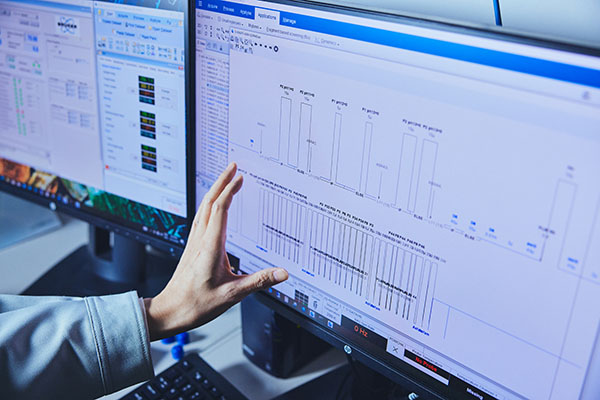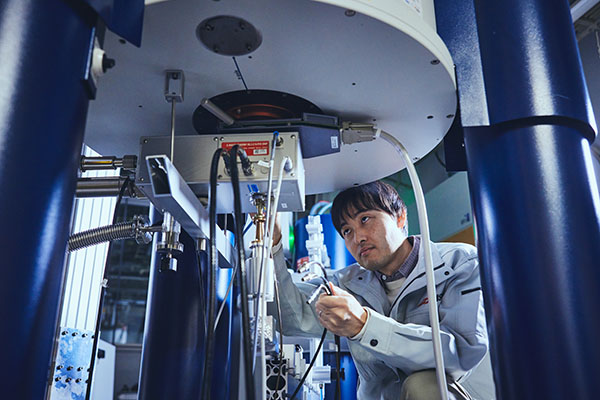Key Point
What is happening in the microscopic world? Throughout history, science has advanced and transformed the world by tackling invisible structures and uncovering their secrets.
Until now, it has been difficult to observe the surface structure of solid catalysts using Nuclear Magnetic Resonance (NMR). By developing a new measurement program, we have made it possible to analyze this for the first time in the world.
We interviewed Senior Researcher Nagashima Hiroki of the Innovative Oxidation Team, Interdisciplinary Research Center for Catalytic Chemistry of AIST, who received the AIST Paper Award for this research.
What makes this research amazingThe paper has led to the start of new projects and many invitations to give lectures.
It is not only cutting-edge basic research in NMR technology, but also has the potential to be applied to material development and other areas.
Could you tell us about the background of selecting solid-state NMR as your research focus?
Nagashima“Until now, solid-state NMR has not been a focus of attention in the characterization techniques of the solid surface. It is a relatively new NMR method, and in Japan, there are only three NMR devices (at AIST, Kyoto University and Osaka University) capable of performing the experiments that led to the paper, and there are only a few researchers in this field worldwide. Even as a specialist in this field, I thought it was a challenging topic when I first started research”.
The results were published in the highly regarded American Chemical Society journal.
“Ultimately, we were able to develop a world-first NMR method, and it was also highly evaluated by experts in the same field, so it was a major breakthrough in characterization techniques of solid surface. The decision to publish in the American Chemical Society journal was based on whether this new analytical technique was widely useful in a variety of chemical fields, and I think it was recognized from that perspective as well.
The actual program is not disclosed in the paper, but we can provide it if there is a request. I think that analytical technique is a tool, and the more there are, the better, and the best thing is for as many people as possible to use it”.
Has the paper lead to any changes in the way you conduct research or the direction you take it?
Nagashima“One key factor that led to our selection for the JST PRESTO program was the technological originality of being able to measure specific atomic nuclei that were difficult to analyze with conventional techniques. This funding is significant for young researchers, allowing us to expand the scope of our work.
We started with basic research to develop NMR programs, but now the focus of our research is shifting to utilizing these measurement methods, and the number of people involved in our research is increasing.
If we can analyze the detailed structure of solid surfaces, we can also make progress in materials development. I think that the interesting thing about AIST is that we don't just do basic research, and I'm working on that”.
Your research has attracted considerable attention, including numerous invitations for guest lectures.
Nagashima“Those who invite me to give lectures generally fall into two groups: those interested in the fundamentals and methodology of NMR itself and those who want to hear about where it can be applied. The former are mostly overseas, and are experts in the same field as me. The fact that we have received invitations from researchers in countries that have been leading this area of study suggests that our technique is now recognized globally.
The latter group primarily consists of domestic companies from a wide range of industries, including chemistry, materials, and pharmaceutical manufacturers. A common request comes from companies that own solid-state NMR instruments and want to gain more detailed insights into the surface structure of solid catalysts. There are high expectations for new information and analytical methods”.
 Changing components in the solid-state NMR probe to measure different types of nuclei.
Changing components in the solid-state NMR probe to measure different types of nuclei.
I want people like you to know about this“With high interest from companies, 17 corporations have already consulted with us, and collaborations with 3 companies are underway.
This analytical technique contributes to the development of solid catalysts, porous materials, nanoelectronics materials, etc.”.
How are you currently progressing with corporate collaborations?
Nagashima“For example, this NMR method can be applied to the measurement of solid catalysts. Many solid catalysts contain oxygen, but oxygen is usually a difficult nucleus to detect NMR signal. This technique improves the measurement program so that even oxygen, which is difficult to detect, can be measured with high sensitivity. Furthermore, not only improving the measurement program, but also replacing the oxygen contained in the sample with an isotope makes it easier to measure. We are considering more flexible solutions, such as combining this isotope enrichment with the developed measurement method.
Using the current program alone, we can measure about one sample per day. However, by combining with isotope enrichment, we can measure 5 to 6 samples per day. Since this method is technically and costly challenging for companies to implement independently, those who consult us highly appreciate our approach”.
 Original measurement program
Original measurement program
What future applications and developments do you expect?
Nagashima“In addition to solid catalysts, it can also be applied to other things, such as nanoparticle quantum dots and porous materials. If we can understand the structure of materials at the atomic scale, it will lead to an understanding of how their functions emerge. Understanding functions will be useful for the development of next generation materials and will in turn contribute to the development of the materials and chemical industries and to carbon neutrality.
NMR analysis of ecosystem functions is also progressing, but if it is possible to analyze proteins and oxygen-containing parts, we will be able to obtain new structural information. It also has the potential to be used in industrial products, electronic materials, cement and concrete, pharmaceuticals, etc.
It is expected to be applied to fields where detailed information on how catalytic reactions occur could not be obtained because the main component, oxygen, could not be measured. If we can measure the state before and after the reaction and understand in detail how the components change their structure and affect performance, it will accelerate the direction and speed of development”.
In the future, what kind of people would you like to be engaged in this research and how would you like them to be involved?
Nagashima“First of all, I would like to see this technique become widely known among researchers working with inorganic solids and materials, which are most directly related to this technique, as well as many other people involved in materials development.
It is extremely difficult to understand the structure of solid surfaces. Analyzing the detailed structure of these surfaces will lead to advances in materials and chemistry, and this is one of my goals. I hope that the findings of this research will form the basis for the further development of a more prosperous society.
If you are interested in this research, please contact us”.
 Crawling under the solid-state NMR device to prepare for measurement
Crawling under the solid-state NMR device to prepare for measurement